Art and Statuary in the Capitol Rotunda
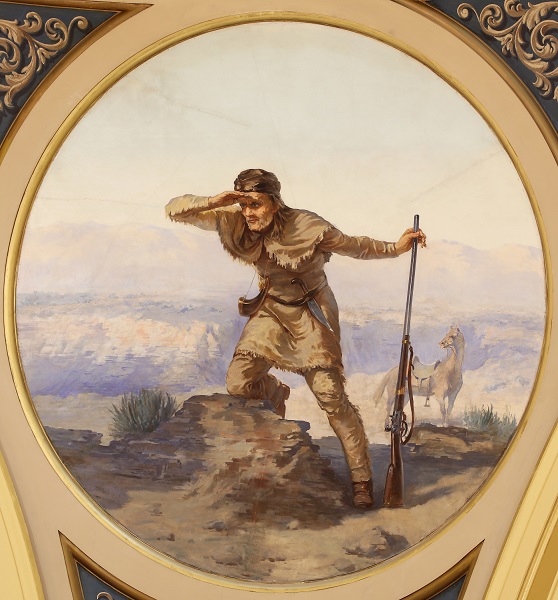
F. Pedretti’s Sons, oil on canvas, 1902, 84" in diameter
(Photo courtesy Tom Ferris for MHS)
In the Rotunda, four large roundels depict four characteristic “types” who played significant roles in Montana’s early development. Although the figures are meant to symbolize general themes, three of the four murals also depict specific men. This roundel’s image of famous mountain man Jim Bridger (1804–1881) acknowledges the contributions of trappers and explorers who first opened up the mountain West for Euro-Americans.
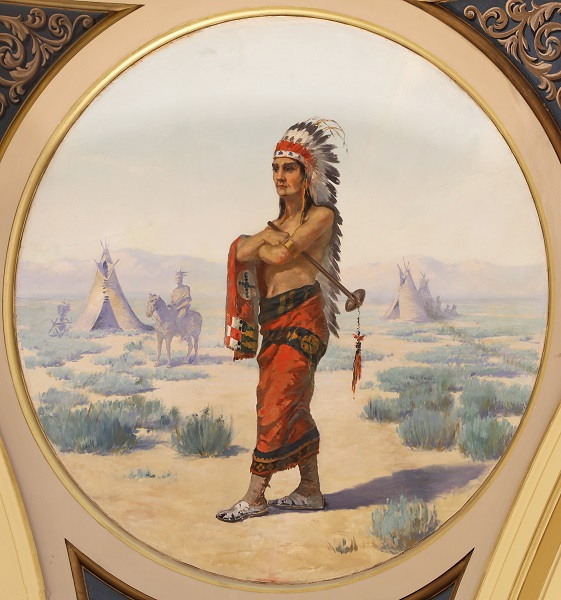
F. Pedretti’s Sons, oil on canvas, 1902, 84" in diameter
(Photo courtesy Tom Ferris for MHS)
Governor Toole chose Salish chief Charlo (1830–1910) to represent Montana’s First Peoples. Charlo, Slem-hak-kah (Little Claw of a Grizzly Bear), was born in the Bitterroot Valley of western Montana. He became the Salish tribes’ hereditary leader upon the death of his father, Victor, in 1870. For forty years he defended Salish treaty rights against the machinations of the federal government and consistently placed the welfare of his followers above personal gain.
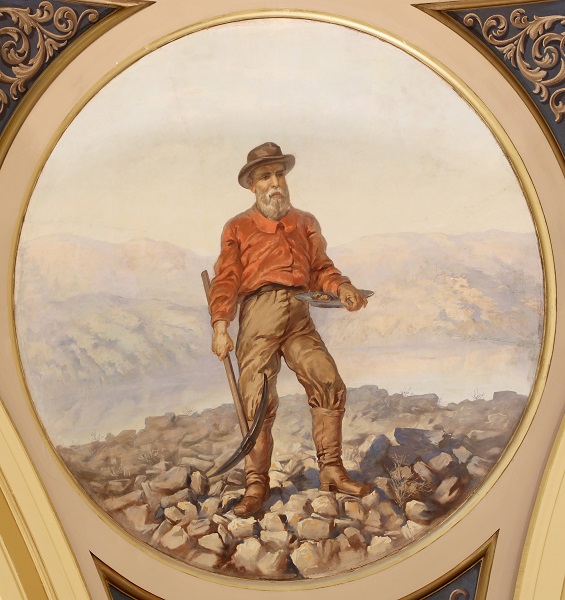
F. Pedretti’s Sons, oil on canvas, 1902, 84" in diameter
(Photo courtesy Tom Ferris for MHS)
The exploration of Montana’s vast mineral wealth originated with the humble efforts of prospectors such as Henry Finnis Edgar (1826–1910), pictured here with pickax and gold pan. Of the six men who discovered gold in Alder Gulch in 1863, Edgar achieved the greatest success and standing in the community.
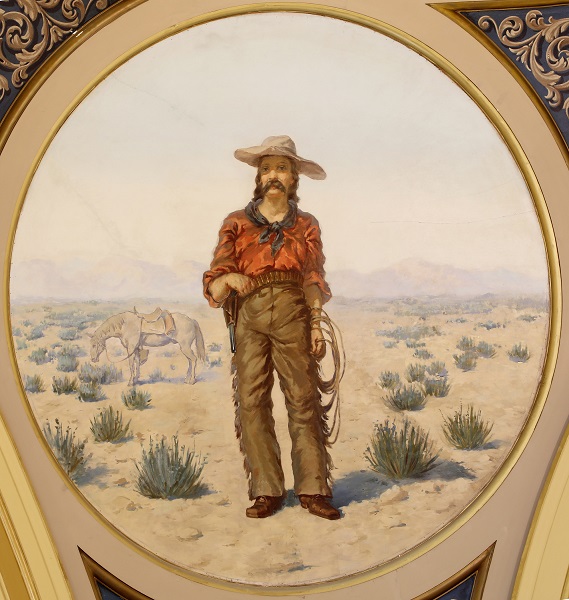
F. Pedretti’s Sons, oil on canvas, 1902, 84" in diameter
(Photo courtesy Tom Ferris for MHS)
The cowboy, already a mythic figure by 1902, finds a place in the Rotunda not only because of the romantic aura of his work, but as a representative of the prosperity brought to Montana by the cattle industry. Curiously, this is the only one of the four roundels for which Governor Joseph K. Toole did not provide the name of a particular individual. Instead, for guidance he referred the Pedretti firm to the paintings of Charles M. Russell.
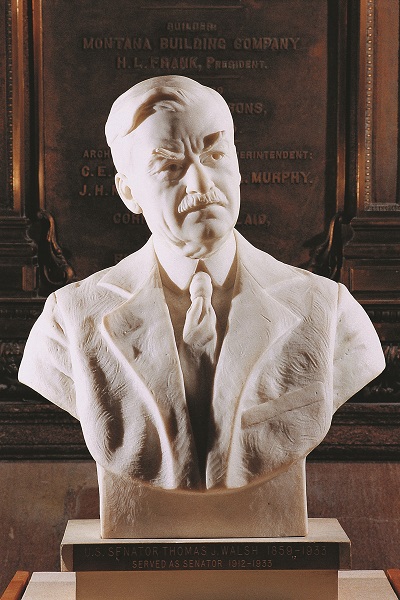
Louise K. Sparrow, marble, 1930, 29" x 21" x 12"
(Photo by John Reddy)
A native of Wisconsin and graduate of the University of Wisconsin Law School, Thomas J. Walsh (1859–1913) moved to Helena in 1890. He earned a reputation for his honesty and respect for his work on behalf of injured industrial workers. He was elected to serve Montana in the U.S. Senate in 1911, and served until his death in 1933. He gained national prominence in 1924 when he exposed the Teapot Dome scandal—the illegal leasing of naval oil reserves by the Warren G. Harding administration. Incoming President Franklin D. Roosevelt appointed Walsh as U.S. Attorney General, but he died en route to Washington, D.C., before assuming that office. Louise K. Sparrow’s (1894–1979) white marble bust of Walsh was dedicated in 1930, the last year Walsh was elected to the Senate.
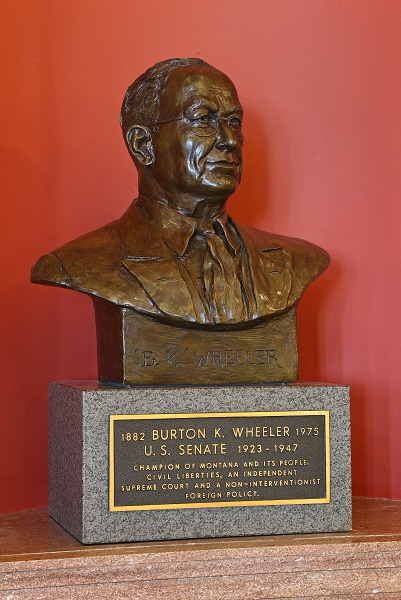
Robert M. Scriver, bronze, 1977, 30" x 19" x 12",
cast by Arrowhead Bronze Foundry, Kalispell
(Photo by John Reddy)
Burton K. Wheeler (1882–1975) served in the U.S. Senate on Montana’s behalf from 1923 to 1947. He played a major role in passing the Indian Reorganization Act (The Wheeler-Howard Act), part of President Franklin Delano Roosevelt’s New Deal. The act acknowledged Native American rights, established the framework for tribal self-governance, and ended the system of land allotment. He also ran as Vice President on the Progressive Party ticket in 1924. During the World War I era, Wheeler was appointed as a United States Attorney, where he defended First Amendment protections in the face of wartime hysteria. In 1977, the legislature approved the placement of a memorial sculpture in the Capitol, completed by Browning artist Bob Scriver (1914–1999).
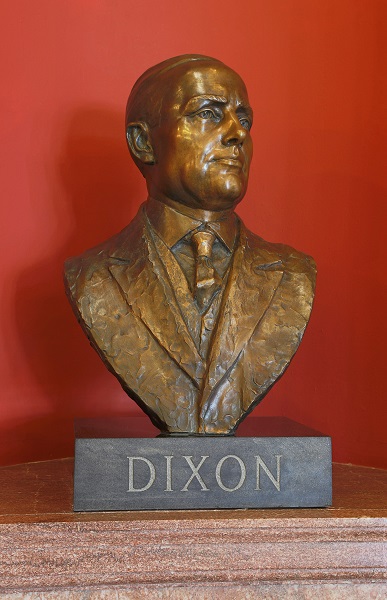
John W. Weaver, bronze, 1972, 28" x 15" x 11"
(Photo courtesy Tom Ferris for MHS)
In 1891, North Carolina native Joseph M. Dixon (1867–1934) moved to Missoula, where he quickly entered into politics. He served as Montana’s United States representative from 1903 to 1907, and was the main proponent of the 1904 Flathead Allotment Act, which called for the allotment and surveying of the Flathead’s land without their consent. Dixon also served as a senator from 1907 to 1913. An advocate of railroad regulation, mining-law reform, and a graduated income tax, Dixon’s most memorable achievement was changing Montana’s tax code so that mining companies paid their fair share of taxes. This effectively ended Dixon’s political career, as it pitted him against the interests of the powerful Anaconda Copper Mining Company. In 1971 the state legislature authorized a memorial for Dixon, and in 1972 John W. Weaver (1920–2012), a Montana-born artist, completed the bronze cast of Dixon that now resides in the Capitol Rotunda.
